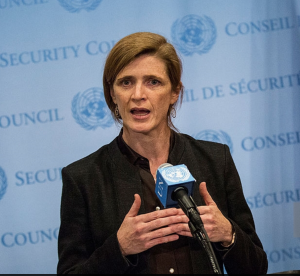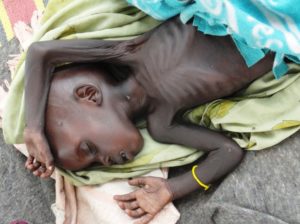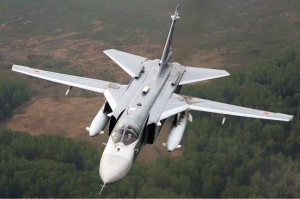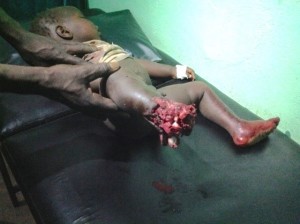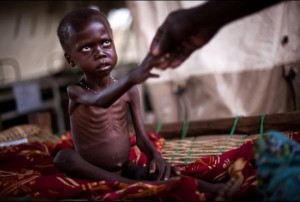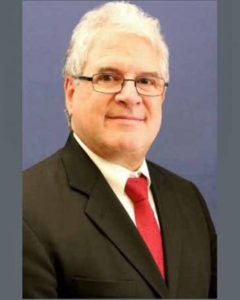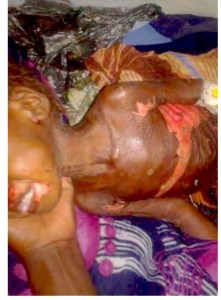Rewarding Policies that Starve Children in the Nuba Mountains of South Kordofan
Eric Reeves | August 18, 2017 | http://wp.me/s45rOG-8046
Sudan Tribune | August 22, 2017 | http://www.sudantribune.com/spip.php?article63285
The National Islamic Front/National Congress Party regime in Khartoum has continued for over six years with its brutal, immensely destructive humanitarian blockade of rebel-controlled areas of South Kordofan and Blue Nile states. The results in the Nuba Mountains of South Kordofan have been devastating, and the poor harvests that seem likely this year because of weather conditions will make things much worse.
Despite the continuation of the blockade, and despite “humanitarian access” as a key U.S. requirement for the permanent lifting of U.S. economic sanctions, the Trump administration—confused and easily strong-armed by the U.S. intelligence community—gives all signs of indeed lifting sanctions on Khartoum this coming October 13th, less than two months’ time from now.
To be sure, it was the Obama administration that began this accommodation of the regime’s génocidaires, declaring in a preposterous and viciously expedient statement that there had been a “sea change” of improvement of humanitarian access in Sudan—including in this characterization of where “access” had improved both Darfur (where Khartoum continues to deny humanitarian access to roughly a third of the 3 million people the UN declares are in need of assistance) and South Kordofan.
Obama administration ambassador to the UN Samantha Power preposterously declared (January 13, 2017) that there had been a “sea change” of improvement in humanitarian access in Sudan
We learn how destructive the Obama administration’s gross misrepresentation of access issues is in a piece from Bronwen Dachs, which appeared yesterday in The Boston Pilot; Dachs has worked as a reporter in Africa for Catholic News Service (CNS) for more than a quarter of a century.
The entire dispatch appears below, but I highlight a moment that should bring the deepest shame to those members of the Obama administration who put in motion the move to reward Khartoum by initially lifting sanctions:
“Here, I have shed tears watching emaciated women with babies on their backs being turned away when they get to the front of the long line because there is nothing left for them,” Oliver Waindi, executive director of the Bishop Gassis Relief and Rescue Foundation, told CNS. “The suffering is as I imagine hell to be.”
“There are a lot of children dying here,” Waindi said, noting that before the changed weather patterns of the past two years, “people had very little to eat, but now they have nothing at all.”
Nuba child dying of starvation
Could there be a greater crime against humanity than to deny people in the most acute distress the most basic means of living? (See my discussion of this question in “On the Obstruction of Humanitarian Aid,” African Studies Review, Volume 54, Number 3 (December 2011), pages 165 – 74 | http://wp.me/p45rOG-I6/). And yet it continues, and all signs from U.S. diplomats and military/intelligence officials make clear that the decision will be to lift permanently sanctions on this heartless and cruel regime, one that remains on the State Department list of “state sponsors of international terrorism”—and with good reason (see | http://wp.me/p45rOG-220/).
Khartoum’s Ambitions in the Nuba Mountains
Many things seemed to have escaped the attention of—or simply been ignored by—the Obama and Trump administrations. There were really only two significant conditions for the permanent lifting of sanctions: (1) improved humanitarian access (the degree of “improvement” left conveniently unspecified) and (2) the end of offensive military actions, including aerial bombardment of the Nuba Mountains—by Antonov bombers attacking fields, agricultural production, and civilian villages, and by much more precise military aircraft (e.g., the Sukhoi-25’s in the regime’s air force, which have repeatedly, deliberately attacked hospitals, including one operated by Doctors Without Borders/Médecins Sans Frontières (MSF).
A Sukhoi-25, used to attack the MSF hospital in Frandala, South Kordofan for a second time
Young Nuba child severely injured by an Antonov bombing attack
Perversely, by prohibiting aerial strikes, the Obama/Trump administrations have made all the more important the maintaining of the humanitarian blockade on South Kordofan and Blue Nile. War in these regions has been predominantly war against civilians: they have been the primary targets of aerial as well as ground assaults since violence began in early June 2011. Denied military opportunity to complete their ambitions in these two areas—historically aligned with South Sudan militarily and politically during the long civil war (1983 – 2005)—Khartoum depends even more now upon humanitarian blockades to subdue the rebellion growing out of the regime’s terrible abuses of the people of these regions.
The identification of the civilian population with the military resistance is made clearest in a passage from leaked minutes of an August 31, 2014 meeting of the most senior military and security officials of regime (the authenticity of these minutes has been established beyond reasonable doubt, and even the U.S. State Department acknowledges their authenticity; see | http://wp.me/p45rOG-1w5/).
At one point in these minutes (which can be found in their entirety, including the Arabic original, at | http://wp.me/p45rOG-1wk/), we hear from General Siddiq Amer, Director General of Intelligence and Security:
Let us continue to dismantle the armed movements. The mechanisms to do that are already in place and working. This year the Sudan People’s Army (SPLA) managed to cultivate large areas in South Kordofan State. We must not allow them to harvest these crops. Good harvest means supplies for the war effort. We must starve them, so that, commanders and civilians desert them and then we can recruit the deserters to use them in the war to defeat the rebels.
Of course it was not the Sudan People’s Liberation Movement/Army-North (SPLM/A-N) that cultivated the crops but the people of South Kordofan. No doubt bountiful crops assist the SPLM/A-N to survive, but the conflation of the people of South Kordofan (the “cultivators”) and the SPLM/A-N is all too telling. And it is reflective of war policies by this regime in its various genocidal counter-insurgency efforts—in Darfur, in the oil regions of South Sudan, and in the Nuba Mountains during the terrible years in the 1990s when the regime declared a fatwa against the Nuba people and imposed a precedent-setting humanitarian blockade.
One victim of Khartoum’s humanitarian blockade of the Nuba Mountains
Consequences of Lifting Sanctions Permanently
Again, the Trump administration again gives every sign of permanent lifting sanctions on Khartoum, first imposed in 1997 by President Clinton in response to the regime’s conspicuous support of international terrorism—Osama bin Laden resided in Sudan from 1992 – 1996, the years in which al-Qaeda came to fruition. Notably, the Clinton Executive Order imposing sanctions emphasized in its Preface “the prevalence of human rights violations, including slavery and the denial of religious freedom” (this language was ignored out of ignorance or mendacity by the current senior U.S. official in Khartoum, Charge d’Affaires Steven Koutsis | http://wp.me/p45rOG-24G/).
U.S. Charge d’Affaires in Khartoum, Steven Koutsis
How will Khartoum respond to this grossly misconceived decision by the Trump administration?
Convinced that there will be no re-imposition of sanctions, no matter what it does domestically, the violence will increase in South Kordofan and humanitarian access will continue to be denied until South Kordofan is starved into submission. Military victory over the Darfur rebel groups was completed with the ghastly Jebel Marra offensive of 2016, in which chemical weapons were used against civilians.
An infant dying from a chemical weapons attack by Khartoum in the Jebel Marra region of Central Darfur; see the September 2016 Amnesty International report at | https://www.amnesty.org/en/latest/news/2016/09/chemical-weapons-attacks-darfur/
And while violence remains at extremely high levels, this is primarily the responsibility of the militias, most notably the Rapid Support Forces (RSF)—now officially incorporated into the regular Sudan Armed Forces (SAF). And since the RSF will be redeployed to finish the military job in South Kordofan during the coming dry season (beginning in November/December), the people will be left at the mercy of the more irregular Khartoum-sanctioned Arab militia groups that are already responsible for most of the continuing predations upon African tribal groups, both in camps for displaced persons and in rural areas, where farms continue to be violently expropriated from their African owns on a wide scale (see | (“Changing the Demography”: Violent Expropriation and Destruction of Farmlands in Darfur, November 2014 – November 2015″ | December 1, 2015 | http://wp.me/p45rOG-1P4/).
In South Kordofan Khartoum will find the SPLM/A-N badly divided between the brilliant leader of the Nuba, Abdel Aziz al-Hilu and his Blue Nile counterpart, Malik Agar, and senior SPLM/A-N official Yasir Arman. Even with forces united, resistance would have been extremely difficult, given Khartoum’s redeployment of the RSF and its ability to focus militarily exclusively on South Kordofan and Blue Nile. Divided, the SPLM/A-N is greatly weakened.
The consequences of the apparently inevitable military victory are too hideous to contemplate, especially given the fierce success of SPLM/A-N military resistance to date. But one thing I know from my time in the Nuba in January 2003—as the broadest outline of the Comprehensive Peace Agreement (January 2005) were coming into focus—is that the people of the Nuba will fight to the death. There will be no surrender, since in the view of the Nuba people surrender entails submitting to cultural extinction, loss of all land rights, and constant abuse by the immense holding force Khartoum will put in place.
Humanitarian access may finally be granted, but only after military victory—and even then, only on what will be a thoroughly punitive and vengefully dilatory schedule set by Khartoum (which has refused to negotiate such access in good faith since the February 2012, when the Tripartite Agreement on access was first proposed by the UN, the African Union, and the Arab League).
The Nuba will have been destroyed.
***********************************
“In Sudan’s Nuba Mountains, no food left, and children are dying,” The Boston Pilot,
August 17, 2017 |
http://www.thebostonpilot.com/article.asp?ID=180076
by Bronwen Dachs
When people talk about potential famine, they mention South Sudan. But about 1 million people who live just over the border, in Sudan’s Nuba Mountains, also face a food emergency.
“I call it famine,” said Bishop Macram Max Gassis, retired bishop of El Obeid, Sudan. The “hunger the people are experiencing” in the Nuba Mountains is “not totally due to the cruelty of nature but, unfortunately, is man-made.”
A survey in the diocese’s area of operation, published in June, found that 74 percent of respondents had no food in their homes and 55 percent had, in the previous 30 days, at least one member of the household go a whole day and night without eating at least once.
South Sudan won its independence from Sudan in 2011, and Nuba was a disputed region that remained in Sudan, despite its people’s affiliations with the South.
Today, people in Sudan’s Nuba Mountains are being bombed by their own government, Bishop Gassis told Catholic News Service. The Diocese of El Obeid issued a statement in early August stating that Nuba communities “are surrounded by battle lines, effectively isolated.” It said delivery of basic services by the Sudanese government and international humanitarian organizations stopped in mid-2011.
The diocese “is one of a handful of humanitarian actors delivering critical and life-saving assistance in the area under extremely difficult conditions characterized by high levels of insecurity,” its statement said.
The suffering “is evident in the vast number” of people needing food aid and is worse than any previous suffering in the memory of any diocesan staff member, the statement said.
“Here, I have shed tears watching emaciated women with babies on their backs being turned away when they get to the front of the long line because there is nothing left for them,” Oliver Waindi, executive director of the Bishop Gassis Relief and Rescue Foundation, told CNS. “The suffering is as I imagine hell to be.”
“There are a lot of children dying here,” Waindi said, noting that before the changed weather patterns of the past two years, “people had very little to eat, but now they have nothing at all.”
Bishop Gassis said last year, the rainy season was poor, and this year floods have ruined what little people were able to plant. “To give you a picture of how bad things are,” residents of the Nuba Mountains are walking for weeks to seek refuge in South Sudan, Waindi said. “They do that because, in South Sudan, when their turn comes to get a simple bowl of grain, they are more likely to get it,” he said.
[Dachs has covered Africa for CNS for more than 25 years.]

